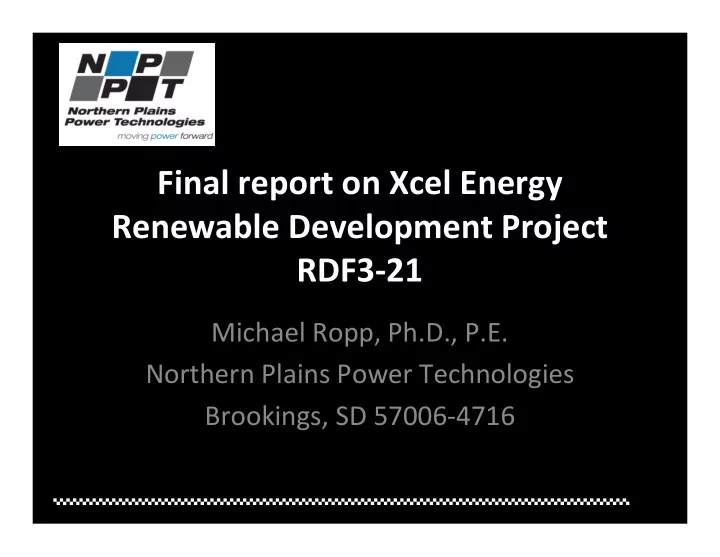

Final report on Xcel Energy Renewable Development Project RDF3-21 Michael Ropp, Ph.D., P.E. Northern Plains Power Technologies Brookings, SD 57006-4716
Acknowledgments Project funding provided by customers of Xcel Energy through a • grant from the Renewable Development Fund. Co-authors: • – Dustin Schutz – Dij Joshi Enernex (Knoxville, TN) • – Jens Schoene – Robert Zavadil Project enhancement via funding from the U.S. Department of • Energy’s Solar Energy Grid Integration Systems (SEGIS) program. SEGIS collaborators: – Advanced Energy (Bend, OR) – Schweitzer Engineering Laboratories (Pullman, WA) – Portland General Electric (Portland, OR) 2
What is islanding? This is a generic distribution feeder. If part of the feeder is isolated by any of the blue switches from the “Utility V” at the left (“loss of mains”), any distributed generators, such as the PV plants shown in green, need to stop energizing the isolated part of the grid. If they don’t, that section of the grid that’s still energized is an unintentional island . 3
The problem solved by this project • Today’s inverter-based distributed generation (DG) uses “active loss of mains detection (A-LOMD)”. Very effective as long as you don’t have much DG. • However, we now are seeing more DG than is compatible with A-LOMD. • Also, with higher DG amounts, want DG to act as a generation asset—incompatible with A-LOMD. • Need new LOMD methods that work for all combinations and amounts of DG, for all parts of the system, and are compatible with generation asset functions (“grid support functions”). 4
Project achievements • Built highly detailed models of three Xcel Energy feeders, and of multiple types of DG – PV – Wind (Types III and IV) – Engine-genset (diesels, anaerobic digesters, others) • Studied two families of islanding detection methods – Harmonic signature-based LOMD (HS-LOMD) – Synchrophasor-based LOMD (SB-LOMD) • SB-LOMD is where the SEGIS funding was used • HS-LOMD uses sophisticated signal processing to detect unintentional island formation • SB-LOMD uses differences in local and remote synchrophasor measurements for detection 5
An example HS-LOMD project result The NPPT team developed one new HS-LOMD method during this work. The idea is that while grid-tied, df/dt is either very slow (systemwide changes) or very fast (local transients). During an island, the bimodal distribution becomes unimodal, or at least more so. We can detect this. 6
How SB-LOMD works PMU = “phasor measurement unit” Two PMUs, one local (right next to the DG) and one reference (upstream on the system), send time-aligned voltage and current phasor measurements to a processor at the DG. The processor compares the phasors to see whether it’s islanded. 7
Example SB-LOMD project result Island event. Island is clearly detected less than a half-second after it forms. System event in which DG ride- through is desired. Here, SB- LOMD does not trigger a “trip”; DG stays online and supports the grid, as desired. 8
Take-away messages • This project has advanced the state of the art of unintentional islanding detection and prevention, thereby enabling DG deployments without compromising safety and security. • Two all-new LOMD methods were invented and characterized, and several others were studied in detail. 9
THANK YOU! The people of NPPT gratefully acknowledge the financial support of Xcel Energy and its customers through the Renewable Development Fund. michael.ropp@northernplainspower.com 10
Recommend
More recommend